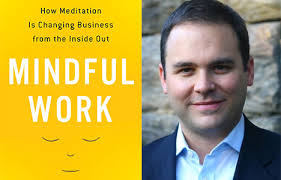The old paradigm of leadership viewing employees as objects to maximize, with long, grueling schedules and few breaks is shifting. Now, effective leadership recognizes that employees, as human capital, are the company’s most valuable asset and deserve the treatment associated with that title. There is a new movement afoot to improve employee well-being, and for those entrepreneurs and earlier stage companies that don’t have the budget to compete with a company like Google on employee perks, you’ll be pleased to hear there is a resource that is, aside from the expense of hiring teachers, entirely free and available to anyone. What is it? Meditation and mindfulness.
This movement is transforming the way we live and how we lead our organizations. David Gelles, a business reporter for the New York Times has been practicing meditation for 15 years, including a stint in India at Bodh Gaya. In his new book Mindful Work, he offers a unique perspective on the intersection of mindfulness and work.
I recently interviewed David about his book and asked him what he had discovered to be the most compelling case for mindfulness. He told me about a program that Aetna implemented with hundreds of thousands of their employees to introduce a mindfulness and gentle yoga practice.
After 10 weeks, the self-reported stress levels went down for these employees, and; perhaps even more fascinating, biometric measurements like heart rate and cortisol went down too, demonstrating that the effects weren’t merely psychosomatic. Other benefits reported include improved sleep quality, reduced pain levels, and higher productivity.
Aetna has saved about $2,000 per employee in healthcare costs, and gained about $3,000 per employee in productivity with the implementation of this single program.
In his book, David interviews employees at companies like General Mills, Green Mountain Coffee, Google, Ford, and LinkedIn and shows how these organizations have implemented mindfulness practices among their employees from the factory floor to the executive suite. Gelles even discusses some of the earliest and most surprising adopters of mindfulness in the US from Henry David Thoreau to Monsanto. David does an excellent job of synthesizing much of the research to date showing that mindfulness lowers stress, increases focus, enhances compassion, and even alleviates depression among workers.
Tipping Point
Gelles believes we are at a tipping point where companies are recognizing there is a real appetite for mindfulness at work. He believes mindfulness is going mainstream for three main reasons:
1. Research.
Over the last few decades, a real body of research has become available proving that mindfulness meditation engenders real lasting benefits to our brains and bodies. These studies are coming out of major research institutions across the country, providing a validity that is convincing to even the most mainstream and skeptical of managers and Human Resources departments.
2. Top Leadership Endorsement (Not just for “woo woo” hippies anymore).
At the same time, David shared, “we’ve seen a gradual realization in the business world that it’s ok to meditate.” Because mindfulness can be viewed as separate from religion, much of the negative stigma around it being too “woo woo” is starting to fall away. As Arianna Huffington likes to say, “2013 is the year top CEOs came out of the closet…as meditators.”
With highly successful business leaders including Steve Jobs, Jeff Weiner, Bill Ford, Larry Brilliant, Oprah Winfrey, and Ray Dalio advocating for mindfulness, it’s hard to ignore; “Meditation more than anything in my life was the biggest ingredient of whatever success I’ve had,” said Ray Dalio, the billionaire founder of Bridgewater Associates – the world’s largest hedge fund firm – in 2012.
3. Technology And Multi-Tasking.
The third reason David believes mindfulness has gone mainstream is because our days are so jam packed, the velocity of our work days always increasing, and digital inputs surrounding us 24/7, that a small taste of mindfulness – to be in the present moment – is really welcome.
Whatever the reasons, with mindfulness on the cover of Time Magazine, and top CEOs touting the benefits, it is clear there is a movement afoot. The advantages of implementing a mindfulness practice at work are significant, everything from improving productivity, to lowering stress and increasing focus, and the risks are negligible.
So, given all this research, and the low implementation cost, why not give it a try? If you’re curious about meditation, here is a Free 30 Day Meditation Challenge that starts April 6th and only takes 5 minutes a day.
From: Forbes


